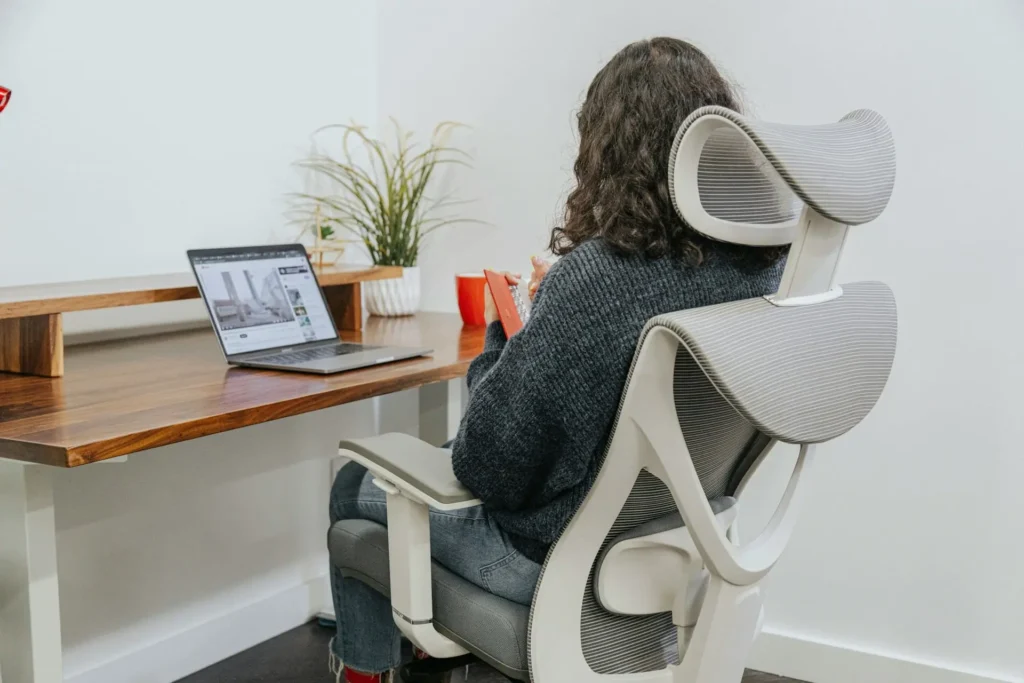Choosing the right ergonomic office chair is more than just a matter of comfort, it is an investment in your health and productivity.
Whether you’re working from home or in a corporate setting, the chair you sit on for extended hours can significantly impact your posture, energy levels, and overall well-being.
Long hours of sitting on an improperly designed chair can lead to a host of problems, including chronic back pain, neck stiffness, and poor circulation. Over time, these issues can reduce your productivity, affect your focus, and even lead to long-term health complications like spinal disorders or muscle fatigue.
An ergonomic office chair is specifically designed to support the natural alignment of your spine and encourage healthy sitting habits.
By providing features such as adjustable lumbar support, a reclining backrest, and customizable armrests, these chairs minimize strain on your body and promote better posture.
This not only reduces discomfort but also boosts your work efficiency, ensuring you feel energized throughout the day.
Investing in the right ergonomic office chair is essential for maintaining both physical health and peak performance in today’s demanding work environments.
What Type of Ergonomic Office Chair is Best?
Selecting the right ergonomic office chair is essential for ensuring comfort, maintaining proper posture, and enhancing productivity during long working hours.
With a wide variety of options available, it’s crucial to understand the unique features and benefits of each type of ergonomic chair.
Below is an in-depth comparison of popular options and guidance on choosing the best chair based on your needs.
High-Back vs. Mid-Back Chairs
- High-Back Chairs:
High-back chairs are designed to provide comprehensive support to your upper body, including the head, neck, shoulders, and full back. These chairs often include additional features like adjustable headrests and lumbar support, making them ideal for individuals who experience chronic back or neck pain. They are particularly suitable for roles or tasks requiring extended periods of focus, such as programming, content creation, or executive responsibilities. Additionally, the high-back design helps in maintaining an upright posture, reducing the risk of slouching and fatigue.
- Mid-Back Chairs:
Mid-back chairs are a more compact alternative that provides focused support for the mid and lower back. While they may lack the head and neck support of high-back chairs, they are versatile, space-saving, and cost-effective. Mid-back chairs are great for individuals who work in smaller office spaces, have shorter sitting durations, or prefer a less bulky design. These chairs strike a balance between comfort and practicality, making them a popular choice for home offices and shared workstations.
Executive Chairs vs. Task Chairs
- Executive Chairs:
Executive chairs are synonymous with luxury and sophistication. Often constructed with premium materials like leather or high-quality synthetic alternatives, these chairs feature plush cushioning, high backs, and elegant designs. They exude professionalism and are ideal for corporate office settings or managerial roles. Beyond aesthetics, executive chairs are equipped with advanced ergonomic features such as adjustable lumbar support, tilt mechanisms, and reclining options, ensuring maximum comfort and proper posture during long meetings or work sessions.
- Task Chairs:
Task chairs are designed with versatility and functionality in mind. Lightweight and compact, they are perfect for a wide range of tasks and environments, from office work to home setups. These chairs typically include essential ergonomic features such as adjustable seat height, swivel mechanisms, and basic lumbar support. Task chairs are an excellent choice for individuals who require mobility and flexibility in their workspace. Their affordability and practicality make them a go-to option for startups, shared workspaces, and temporary setups.
Mesh Chairs vs. Leather Chairs
- Mesh Chairs:
Mesh chairs are gaining popularity due to their breathability and lightweight design. The mesh backrest allows for proper airflow, keeping you cool and comfortable during long working hours, particularly in warm or humid climates. These chairs often feature modern, minimalist aesthetics, making them a great fit for contemporary workspaces. Despite their light frame, mesh chairs provide adequate lumbar support and can be paired with cushioned seats for enhanced comfort.
- Leather Chairs:
Leather chairs, whether made from genuine or synthetic leather, are known for their premium look and feel. These chairs offer a plush, cushioned seating experience and are ideal for users who prioritize comfort and style. While they may not be as breathable as mesh chairs, leather chairs excel in durability and elegance. They are a perfect choice for executive offices or workspaces where a professional and luxurious appearance is valued. Leather chairs also come in various ergonomic designs, ensuring that you don’t compromise on posture and support.
Key Factors Based on Usage
- Home Office:
For home offices, it’s essential to choose a chair that combines comfort, functionality, and style. A mid-back mesh chair or task chair is a great option, offering ergonomic support without overwhelming your home decor. If you spend extended hours working from home, consider investing in a high-back chair with adjustable lumbar support to ensure long-term comfort and posture.
- Corporate Office:
Corporate settings often demand chairs that provide superior comfort and a professional appearance. Executive chairs or high-back leather chairs are ideal for such environments. These chairs not only enhance the aesthetics of your workspace but also ensure that you remain comfortable and productive throughout the day. Look for models with advanced ergonomic features like tilt adjustment and reclining mechanisms to cater to long meetings or intensive tasks.
- Gaming:
For gamers, comfort and support are paramount due to the prolonged hours spent in front of a screen. Gaming chairs are specifically designed to cater to these needs, featuring high backs, adjustable armrests, and additional neck and lumbar pillows. These chairs often include reclining and rocking mechanisms, allowing you to find the perfect position for intense gaming sessions or relaxation. Gaming chairs also come in a variety of styles and colors, enabling you to personalize your setup.
Essential Features of an Ergonomic Office Chair
Choosing the right ergonomic office chair involves understanding the features that enhance comfort, support, and productivity.
A well-designed chair should cater to individual needs and provide the flexibility to adjust for optimal posture during long hours of work.
Below are the key features every ergonomic office chair should include:
1. Adjustable Lumbar Support
Adequate lumbar support is essential for preserving the natural curve of your spine and avoiding lower back discomfort. A chair with adjustable lumbar support ensures you can position it to match your unique back shape, offering consistent comfort and reducing strain. This feature is especially important for individuals who sit for extended periods.
2. Adjustable Seat Height and Depth
A customizable seat height allows users of varying heights to ensure their feet rest flat on the floor, promoting healthy circulation and reducing pressure on the thighs. Similarly, adjustable seat depth enables you to position the seat so that there is adequate space (about 2–3 fingers’ width) between the back of your knees and the seat edge. This promotes better posture and prevents discomfort.
3. Reclining Backrest with Locking Mechanisms
An ergonomic office chair should have a reclining backrest that supports your body as you lean back, allowing you to relax your spine and reduce stress on your back muscles. A multi-position locking mechanism lets you secure the backrest at various angles, ensuring stability and comfort during different activities such as typing, reading, or taking a break.
4. 360-Degree Swivel Base and Smooth-Rolling Casters
Mobility is an essential feature for modern office environments. A 360-degree swivel base enables you to turn effortlessly in any direction, enhancing efficiency by reducing the need to strain or twist your body. Smooth-rolling casters allow for easy movement across different surfaces, making it convenient to access various parts of your workstation without getting up.
5. Breathable Materials for Long Hours
The material of the chair plays a significant role in overall comfort, especially during long working hours. Breathable fabrics like mesh enhance airflow, preventing heat buildup and keeping you cool throughout the day. Chairs with fabric upholstery offer a soft, cushioned feel, while still allowing adequate ventilation. These materials not only provide superior comfort but also guarantee long-lasting durability.
How to Measure and Select the Right Chair Size
Choosing the right-sized ergonomic office chair is essential for ensuring proper posture and long-term comfort.
Here’s how you can measure and select a chair that fits you perfectly:
Understand the Importance of Dimensions
- Accurate chair dimensions are crucial to avoid discomfort during extended use. A chair that’s too small or too large can strain your back, hips, or legs, impacting your productivity and well-being.
Measuring Seat Width and Depth
- Make sure the seat width offers ample space for comfortable seating without any sense of restriction. A depth measurement allows you to sit with your back fully supported by the backrest while maintaining a 1-2 inch gap between the edge of the seat and your knees.
Adjusting Seat Height
- The chair height should match your desk and enable your feet to rest flat on the floor for optimal comfort. To measure the ideal height, sit with your knees at a 90-degree angle and check if your thighs are parallel to the ground.
Other Factors to Consider
- Look for chairs with adjustable seat height, width, and depth to customize the fit. Additionally, the armrests should align with your desk to reduce strain on your shoulders and arms.
By carefully measuring and selecting a chair that suits your body type, you can improve your posture and work comfortably for hours.
Conclusion
When choosing an ergonomic office chair, prioritize features that promote comfort, adaptability, and support. Adjustable lumbar support, customizable seat dimensions, reclining backrests, and breathable materials are non-negotiable for a healthy and productive work experience. A chair equipped with these features ensures that your posture is maintained, your body is supported, and your comfort is prioritized, whether you’re working from home or in a corporate office.

